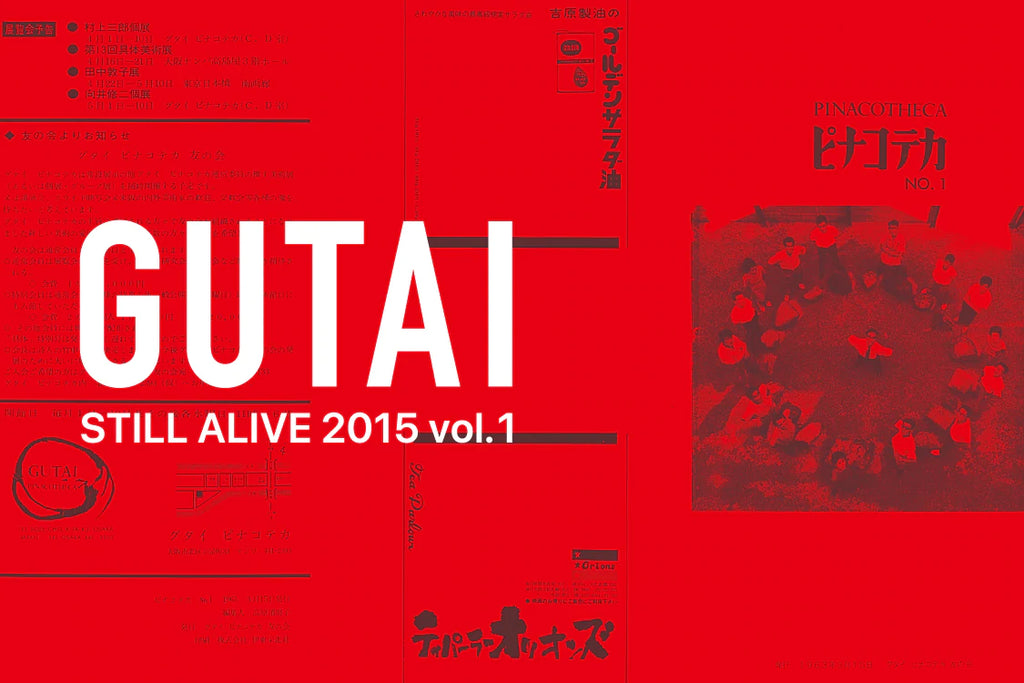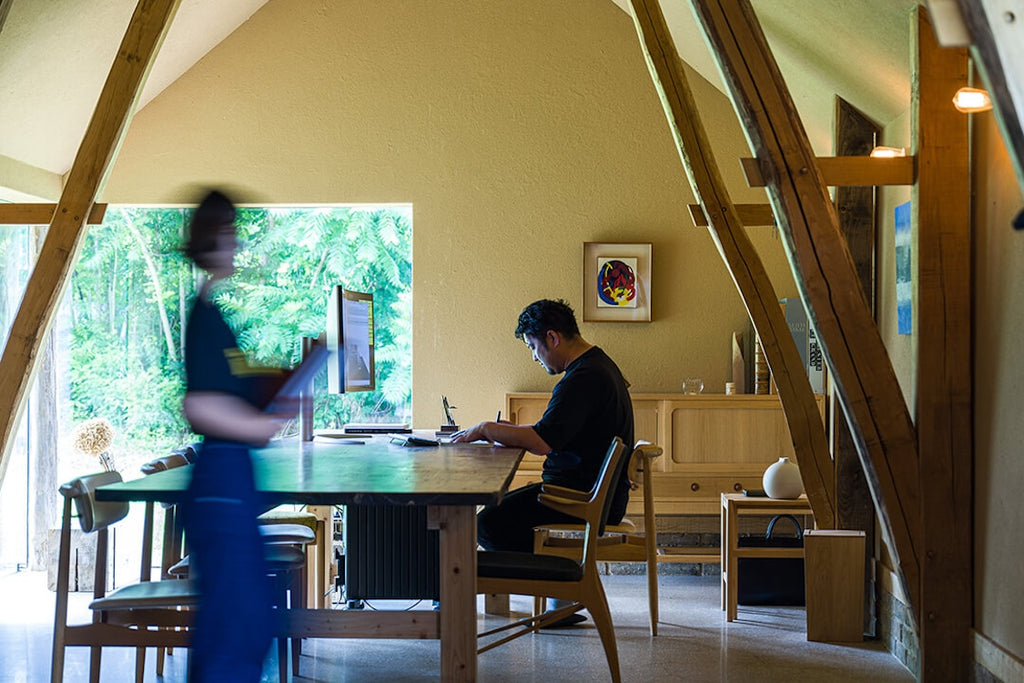ARTICLES
Atsuko Tanaka and Akira Kanayama as an artist couple|Interviews with related parties (Part 1)
GUTAI STILL ALIVE 2015 vol.1
26/35

Atsuko Tanaka drawing a picture at home(Myohoji), 1966, ©︎Ryoji Ito
A series of digital archives of the book "GUTAI STILL ALIVE 2015 vol.1" published by Gutai Art Association. The 26th installment of this series focuses on the relationship between former Gutai members, Atsuko Tanaka (who left the group in 1965) and Akira Kanayama. We spoke to Kanako Ito of Myohoji Temple Osaka, where the two artists had their studio, and learn about their relationship as an artist couple.
Myohoji, Osaka – The Departure and Arrival Point of Akira Kanyama and Atsuko Tanaka 01
The Insights of Kanako Ito: Part 1
In 1952, 2 years before the founding of Gutai, a group of young artists who had rallied together to exhibit new work came to form “Zero-Kai”(group Zero). The group consisted of around 15 members including Akira Kanayama, Kazuo Shiraga, Saburo Murakami, with Atsuko Tanaka joining later at Kanayama’s introduction.
Following this these 4 members would be invited by Shozo Shimamoto to join with the Gutai association and would go on to become some of its leading artists.
Kanayama and Tanaka worked as colleagues since the time of “Zero-Kai” and would later become a married artist couple.
Within Osaka there is a key point which must be mentioned whenever referring to Kanayama, Tanaka and “Zero-Kai.” This is the 350 year old temple Myohoji, set within one of the central districts of Osaka. It may appear somewhat out of place to suggest that there is a connection between a historical temple and a pioneering avant-garde art group, but in fact within the bounds of this temple stood the small studio of Kanayama and Tanaka, which had also previously hosted the meetings of “Group Zero.” One may say that it all began here. It was Myohoji that provided the breeding ground for a new form of post-war art.
Upon the site where the couple held their studio there now stands a small temple hall “Houondo” and within this may be noted the memorial stones to the pair, coming to return to this starting point in their death.
On this occasion we spoke to Kanako Ito, the daughter of Ryoji Ito, once the head priest of this temple. Ryoji Ito was the brother of Kanayama and after retiring it is now Kanako’s brother who has taken on the role of head priest.
In 1965, after resigning from the Gutai group, Atsuko Tanaka came to move here where Akira Kanayama had lived, taking up residence in the grounds of the temple and producing their work together.
Kanako Ito(KI): Akira Kanayama got married with Atsuko Tanaka and came to live in the temple precinct. At that time he was a school teacher and used here as a base for a wide range of activities. And it seems that “Zero-Kai” also used to meet regularly here. I wasn’t born yet at that time but my grandmother liked Kanayama and often did things to help him. Whenever Kanayama, Tanaka and “Zero-Kai” are introduced this temple is always mentioned but for us they were family so we didn’t really know about their artistic activity to be honest.
Kanayama and Tanaka lived here until I was 7 years old. At that time they had already left Gutai. In this detached part of the temple the local children used to gather and learn calligraphy and drawing from Kanayama, while Tanaka constantly painted. Looking at them I had a sense that artists were somehow different from ordinary people. Usually they were very peaceful but when a brush was in their hand such impressive works came forth from such a small body. I really wondered where that energy came from. They worked in silence but created something quite unearthly. I grew up around them and they affectionately called me “Kanako-chan.” I think they doted on me the most.
Ito recognized the couple as family and called Tanaka familiarly as “Acchan”. They were her aunt and uncle living in the temple grounds where her father was head priest, and Ito also saw their works at close hand.
Observing their working relationship Ito felt that Kanayama was highly aware of Tanaka’s talent and was doing the best to provide a comfortable environment for her to continue her production. After dropping out of Kyoto City University of Arts, Tanaka went on to study at the Institute attached to the Osaka City Museum of Fine Arts, and it was here that she met Kanayama. It was through Kanayama’s advise that Tanaka came to focus her practice upon abstract painting. This meeting and influence was to continue for a lifetime. When discussing the work of Tanaka one must always recognize the vital role of Kanayama in supporting her work.
K I : It was Kanayama’s way of talking “If you do simething which is the same with what others do, it is not interesting. You have to do something totally different.” He gave such emphasis to the importance of something being “interesting.” Tanaka really depended on Kanayama on all levels. Even after moving to Asukamura in Nara, Kanayama would come to Osaka regularly, but “Acchan” would always phone up and Kanayama would give her a list of warnings and directions.
He would be saying “Acchan you have to do it like this, don’t do it like that.” There are those paintings with circles and lines, well, he was even advising her about those. There would be a debate about how to draw the line, where it should be. She paid great attention to every line. So you see there is no painting “by chance.” It is all meticulously planned and sketched, with Kanayama giving constant advice. Even by phone they would be having these kind of conversations. Tanaka would also be asking Kanayama to get this color paint and that, and it was even Kanayma who ordered the frames and negotiated with the galleries. And it wasn’t just in her art practice, it was in every aspect of life that Tanaka was supported by Kanayama. He fixed everything so she could just focus on her work. I have heard it from others, too. It was really Kanayama who identified and guided Tanaka’s talent.
I had a sense that Tanaka was always serenely painting. When I spoke to their relatives, they would say the same (laughs). Itseems even if there was some family gathering, a wedding or funeral, Tanaka would be excused.
It was from their base at Myohoji that Kanayama and Tanaka embarked on their independent careers, after having engaged in “Zero-kai” and the Gutai association. In 1972 they moved from Osaka’s Myohoji to Asukamura in Nara and continued to produce large scale work in the peace of their surroundings. Kanako Ito witnessed all of this, describing a unique portrait of the two from a particularly familial perspective.
In March 2005 Kanayama and Tanaka were unfortunately involved in a road accident and Tanaka passed away in December of the same year, and it was Ito who took care of all their hospitalization and nursing, revealing the strength of her connection with the couple.
(Monthly Gallery, September 2014)
(continued on The 28th installment)
Read more about the “Gutai Art Association »
*Information in this article is at the time of publication.
ARTIST
RELATED ARTICLES
-

Myohoji, an Important Base for Akira Kanayama|Interviews with Related Parties (Part 2)
GUTAI STILL ALIVE 2015 vol.1
28/35 -

Akira Kanayama: a Gutai Artist Who Distanced Himself from Jiro Yoshihara
GUTAI STILL ALIVE 2015 vol.1
27/35 -

예술과 건축의 공명|히시다 쇼헤이와 화이트스톤이 그리는 예술적 삶
2024.08.09
ART × ARCHITECTURE -

“Into the Unknown World — GUTAI: Differentiation and Integration” at the Nakanoshima Museum of Art and the National Museum of Art
October 19, 2022
Osaka, Japan



